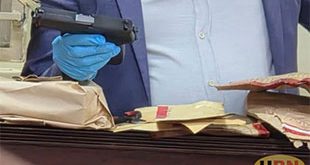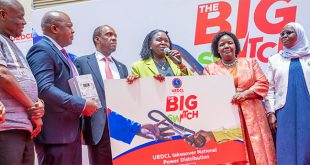
Mbale, Uganda | PATRICIA AKANKWATSA | The Ministry of Agriculture, Animal Industry and Fisheries (MAAIF) under the recently launched Phase 3 of the FAO-China South-South Cooperation (SSC) Programme on June 22nd, launched the Hybrid rice variety (WDR-73) developed by Shanghai Research Institute in collaboration with National Agriculture Research on organisation (NARO).
While speaking at the launch in Mbale, Charles Owach Assistant FAO representative who represented Antonio Querido – FAO Representative said that this rice variety is water-saving and drought resistant- hence important for food security, nutrition and income security and at the same time addresses climate challenges such as drought.
“The WDR-73 rice combines both high yield potential, as well as water-saving and drought resistance, compared to the irrigated paddy and traditional upland rice varieties. This rice variety will address the resource and environmental challenges faced by rice producers,”
He added that from the studies conducted in Uganda, Kenya and Ghana, out of the over 50 varieties of rice tested, on how the grains grow and how they taste, the WDR 73 proved to show huge potential, with the ability to boost yields by about 30 per cent compared to locally grown varieties.
In Uganda, WDR73 cultivation experiments were conducted in Lukaya, Luweero and Arua. In well-managed farms, grain yield increased from 4.35 to more than 6.0 tons per hectare. In Arua, at a growth duration of 90-95 days, these varieties yielded up to 4.35 tonnes per hectare, while direct-seeded WDR 73 grains in Luweero yielded between 6-8 tonnes per hectare.
“As FAO, we are excited to be supporting the government of Uganda, through the South-South Project to scale up the production of this very important water-saving variety adding that: We believe it will help many rice farmers and producers boost their incomes and nutrition, and contribute to economic development,” Owach said.
Stephen Katabazi an Agricultural inspector at MAAIF who represented the minister said that this project will support value addition, mechanization and resource utilisation.
“This phase is for upscaling technology in rice growing and capacity building,”
Dr. Damalie Akwango-Aliau – Climate Change and Adaptation Specialist at NARO noted that their role is to generate technologies and also disseminate them to the users for purposes of improving agricultural production and productivity, hence the introduction of the new variety.
She commended the People’s Republic of China, for the technical expertise and the financial resources they have provided.
“It is our plea that in this phase three, we would like to see more of the integration of ICT in technology generation and dissemination. We’d also like to see more technologies that will enable farmers to produce rice sustainably while conserving the environment.”
She called for the training of more technicians and extension staff since the first and the second phases focused on the scientists.
The project is being implemented in the following districts in the central, eastern, western and Northern regions of Uganda: Alebtong, Amuria, Apac, Budaka, Bugiri, Bukedea, Butaleja, Dokolo, Ibanda, Iganga, Isingiro, Kaberamaido, Kalungu, Katakwi, Kibuku, Kiruhura, Kole, Kumi, Lira, Luwero, Mbarara, Mpigi, Namutumba, Ngora, Otuke, Oyam, Palisa, Serere, Soroti and Wakiso.
Ten long-term experts and technicians from the People’s Republic of China will be deployed through technology transfer, capacity development and trade and investment activities. The project will undertake capacity development activities at all levels through
different modalities such as study tours to China, field training in Uganda, including Training of Trainers (ToT), small- and large-scale technology training centres and knowledge transfer and Farmer Field Schools (FFS). FAO and the Chinese experts will work with technical officials from the Ministry of Agriculture, Animal Industry and Fisheries (MAAIF).
The SSC Project Phase 3 will establish four hub headquarters for integrated technology, livestock, cereals and aquaculture in Luwero, Mbarara, Butaleja and Kajjansi.
The project will contribute to ensuring food and nutrition security, income generation, decent job creation, especially for the youth and women (30 per cent of beneficiaries), and improved livelihoods of at least 9 600 farmers. Direct beneficiaries will also include 200 technical officers attending capacity development studies in Uganda and China. Indirect beneficiaries will include staff from public and private institutions, transporters, traders and consumers.
 The Independent Uganda: You get the Truth we Pay the Price
The Independent Uganda: You get the Truth we Pay the Price



